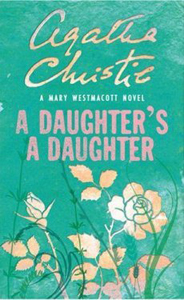In the fifth Mary Westmacott novel, “A Daughter’s a Daughter” (1952), Agatha Christie returns to the almost-autobiography format of “Unfinished Portrait,” my pick for the (relatively) weakest of the Westmacotts so far. This time she laser-focuses on troubled mother-daughter relationships via Ann and Sarah Prentice. She ultimately drifts from real-world issues with her own mother or daughter, but not at the novel’s expense; her personal worries lead to fictional drama.
Christie had initially prepared this material for the stage in the 1930s (around the time she wrote “Unfinished Portrait”), and “ADAD” resurfaced in this century as a well-regarded play.
As a book, it’s better than “Unfinished Portrait,” because it has a central point and doesn’t need a contrived framing mechanism. It does have contrived side characters, who I’ll mention later. “ADAD” is brutal, straightforward and almost fatalistic. “ADAD” again shows that when Christie hews close to her personal life, the work is blunter, with less literary flair than, say, “The Rose and the Yew Tree.”

“A Daughter’s a Daughter” (1952)
Author: Agatha Christie, writing as Mary Westmacott
Series: Mary Westmacott No. 5
Genres: Family drama, romantic drama
Setting: London, 1952
The Prentice Girls
It’s a no-brainer to readers of my blog that I’d compare “ADAD” to TV’s “Gilmore Girls,” the most robust mother-daughter story I’ve experienced, and one I enjoyed throughout its eight seasons. But it is an apt one, even down to the details.
Like Lorelai and Rory, Ann and Sarah’s closeness is both healthy and unhealthy. But aside from parts of Seasons 5 and 6, when Rory undergoes her later-than-usual teenage rebellion, “GG” is about the positive aspect of a mother and daughter being best friends.
Being a dramatic novel of 132 pages within the “Six Mary Westmacott Novels” (making it the leanest other than “Absent in the Spring”), “ADAD” focuses on the Season 6 phase, if you will, for the Prentice girls. It’s well-established that they are like best friends, calling each other “darling.” Sarah doesn’t even dream of moving out of their London flat upon adulthood. But Christie soon brings hidden stressors to the fore.
Marriage options
The “GG” comparison also works for where the women are in their lives. Ann, a widower (40-something, but she looks young), is considering a potential new husband, the lonely, awkward and reliable Richard.
Twenty-something Sarah is weighing good ole Gerry – for whom she’s always cared, even if their passion isn’t white-hot – and rich and handsome Lawrence, who offers her all the material possessions she could want (including, literally, fur coats), plus “sensations.” Here, Christie refers to drugs. The standard critical reaction would be to say the author doesn’t explore Sarah’s drug addiction enough, but having read “Third Girl,” I don’t really want Christie to try to describe drug culture in detail. Less is more, in this case.

Sarah, being a pretty young available woman, and Ann, being a catch for a man approaching middle age, have additional suitors. Marriage potentialities are usually an ongoing mental struggle for Christie’s women, but they are often straightforward for the men – no less painful when it doesn’t work, but easier to figure out.
In the final pages of some Christie mysteries, the man asks the woman (whom he has met and become smitten with during the preceding adventure) to marry him, she agrees, and they live happily ever after. In “ADAD,” the men take their rejections from the Prentice women and retreat like they are a recurring guest-star (think of “GG’s” Max or Dean), to deal with their pain off-page.
“ADAD” is certainly a novel about women, but Christie understands men’s hearts and minds. Consider Geoffrey, a kind but bland longtime friend of Ann’s who has learned she has decided to marry Richard. “I shall miss you, Ann,” he says in Book One, Chapter 5, knowing this is the end of their friendship. Ann doesn’t grasp this. “It will not be the same,” Geoffrey tries to explain. “When a pretty woman marries another man …” He trails off, his point clear enough.
Generational clash
Christie gives hints about what each of the women is thinking as the mother-daughter melodrama comes to a head: Ann wants to marry Richard, but Sarah doesn’t want her to. Sarah doesn’t say this out loud, but she demonstrates it by starting immature rows with her potential father-in-law.
Christie uses two other main characters as cheats to get into Ann’s and Sarah’s heads: Laura, godmother to Sarah, is a successful lecturer on psychology who is only half-joking when she says she hopes no one takes her advice. Laura believes so strongly in the scientific principles of observation and non-interference that it’s hard for her to even steer her friend Ann, let alone give overt guidance.
Edith, the housekeeper who practically raised Ann and then Sarah, loves both women but frowns on the impertinence of the youngest generation and the allowances of the middle generation. That would make her the Emily parallel in my “GG” metaphor, except with less capital in the family power structure. I admit it didn’t dawn on me till the end that Edith is a mother figure, and I appreciate Christie playing this aspect subtly.
No one can hurt you like family
Laura and Edith are underexplored, more “wise mentor” devices than characters. It strikes me as unfair that the Prentice girls get to live out their wild melodramas whereas the older, unmarried women are shunted aside. Laura and Edith would both say they don’t want grand romantic dramas, but they are too underexplored for us to take them at their word.
A critical reading of “GG” likewise can paint Lorelai and Rory as self-centered characters who believe it’s their world and everyone else is their guest stars.
Still, a propensity for self-centeredness is arguably universal, considering that each of us only exists in our own mind and body; “GG” and “ADAD” simply draw attention to this reality. Ann and Sarah are human, as Agatha and Rosalind were. Indeed, if Ann is forced to choose between Sarah and her own happiness, she of course chooses Sarah. But Christie explores what happens next. As wise Laura says: “The trouble with a sacrifice is that it’s not over and done with once it’s made! It goes on.”
“A Daughter’s a Daughter” makes the brutal point that life can be painful because of the way loved ones behave toward each other – even though their love is real and even though they think they are doing the right thing. It’s clear that Christie worried about how her own daughter would feel about her second marriage (IRL, Rosalind turned out to be totally fine with it). She probably bounced those feelings back and forth in her mind.
I don’t know if this novel was cathartic for Christie, but she certainly lays it all out there. The title comes from the saying “A daughter’s a daughter all your life,” and that’s also a hint that a relatively happy ending might be in order. After observing the Prentices’ conflict, the reader deserves one even more than Ann and Sarah do.
Sleuthing Sunday reviews an Agatha Christie book or adaptation. Click here to visit our Agatha Christie Zone.

